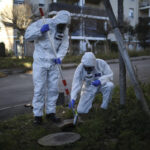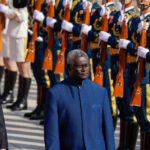BRUSSELS — President Biden and leaders of more than 30 nations convened Thursday to demonstrate united opposition to Russia’s invasion of Ukraine, announcing new economic sanctions, aid for refugees, deployment of additional forces to Eastern Europe and grim preparations in case Russia uses chemical, biological or nuclear weapons.
But the historic gathering of world leaders in a series of three summits on Thursday underscored how the United States and its allies have in some ways reached their self-imposed limits in crafting a united global response to the largest European conflict in more than a half-century. While they are sharpening the tools they are using against Russia, they appear to have few new ones to reach for.
Mr. Biden and the allies have moved with unexpected speed and authority over the past four weeks, rallying much of the world against President Vladimir V. Putin of Russia.

And yet, the sense of stalemate on the battlefield is now also felt in the halls of diplomacy, where taking dramatic new steps to counter Mr. Putin’s aggression is proving difficult. Europeans have said they are not willing to bear the consequences of new limits on the Russian energy that they depend on. And Mr. Biden has said he is not willing to commit troops to Ukraine and risk going to war against Russia.
As the allied leaders met in Brussels, the Ukrainian military, entering the second week of a counteroffensive, claimed on Thursday to have destroyed a Russian military landing ship in the southern port of Berdyansk. In the embattled towns around the capital, Kyiv, intense fighting had set so many fires on Thursday that the city was shrouded in a ghostly haze of white smoke.
Mr. Biden said the United States would accept 100,000 Ukrainian refugees, and he and his counterparts announced a new round of weapons shipments for Ukraine, but not the fighter jets that President Volodymyr Zelensky has pleaded for.
They expressed in one voice their “resolve to counter Russia’s attempts to destroy the foundations of international security and stability.” But they again declined to enforce a no-fly zone in the skies over Ukraine, which would mean readiness to shoot down Russian planes.
They vowed to tighten sanctions on Russia, but the Europeans stopped short of blocking imports of Russian oil and gas, as the United States has done. Europe is hugely dependent on Russian energy, paying Mr. Putin the vast revenues needed to support his military — and giving him the power to wreak havoc on Europe by disrupting supplies.
“I think we’re seeing a coordinated divergence between the European Union and the United States,” said Mujtaba Rahman, managing director for Europe at Eurasia Group. “There’s no rupture or even a split. Rather, there is an agreement that the U.S. will go more aggressively than the E.U. because they can afford to do so.”
Speaking to reporters Thursday evening, Mr. Biden said that he had requested the emergency meetings — with leaders of NATO, the European Union and the Group of 7 industrialized nations — to show Mr. Putin that the allies will not “crack” in their determination to keep economic pressure on Russia over days, weeks, months and more.
“We have to stay fully, totally, thoroughly united,” he said, adding that he favors ejecting Russia from the Group of 20 industrialized and developing nations.
For Mr. Zelensky, though, none of it was enough. He has become more pointed in his criticism of Western restraint on military aid as Russian forces have savaged Ukrainian cities and towns, especially in the south.
Speaking by video to NATO leaders behind closed doors, Mr. Zelensky thanked them for their support but chided them for not doing more. He described his battered country, which is not a NATO member, as trapped “in the ‘gray zone’ between the West and Russia,” according to a transcript released by the Ukrainian government.
“On Feb. 24, I addressed you with a perfectly clear, logical request to help close our skies,” he said of his request for a no-fly zone over Ukraine to keep Russian planes away. “In any format. Protect our people from Russian bombs and missiles. We did not hear a clear answer.”
“And you see the consequences today,” he added a moment later. “How many people were killed, how many peaceful cities were destroyed?”
He repeated his appeal for warplanes, though the White House and the Pentagon have said that supplying them could give Russia a pretext for drawing NATO into a direct conflict. “You have thousands of fighter jets! But we haven’t been given any yet,” Mr. Zelensky said. “To save people and our cities, Ukraine needs military assistance — without restrictions.”
For NATO leaders, the high stakes of their meeting were evident in the joint statement issued at its conclusion. The 72-year-old alliance warned Russia against deploying “chemical, biological and nuclear weapons” in Ukraine, signaling a growing concern that Mr. Putin is willing to use them to advance his aggression or to falsely implicate Ukraine’s government.
Mr. Biden was cautious Thursday in his response to questions about the warning. He declined to say whether the United States or NATO would respond militarily if Russia used chemical weapons, which are banned by international treaty.
“We would respond if he uses it,” Mr. Biden said. “The nature of the response would depend on the nature of the use.”
But in warning about the threat from weapons of mass destruction, NATO’s secretary general, Jens Stoltenberg, said the organization was “enhancing allies’ preparedness and readiness for chemical, biological and nuclear threats.” It will provide detection equipment, protection and medical support to Ukraine, he said, along with training for decontamination and crisis management to deal with the impact of any use of weapons of mass destruction.
The alliance’s top military commander, Gen. Tod D. Wolters, “has activated NATO’s chemical, biological, radiological and nuclear defense elements,” Mr. Stoltenberg added, placing on increased alert NATO teams that specialize in detecting and responding to contamination after a chemical, biological, radiological or nuclear attack. Member nations are taking similar steps.
Mr. Stoltenberg noted that the use of such weapons inside Ukraine could contaminate neighboring NATO countries.
“Many people fear that Russia will use such weapons and accuse Ukraine of doing it, so it is important to precisely determine who, where and when did it so there’s no ambiguity,” said Gustav Gressel, a senior policy fellow at the European Council on Foreign Relations.
The United States hit Russia with a new round of sanctions on Thursday, targeting more than 300 members of its Parliament and dozens of defense companies, while moving to restrict Russia’s ability to use gold reserves to prop up its currency. It also imposed sanctions on Herman Gref, a Putin ally and the president and chairman of Sberbank, one of Russia’s largest banks; the bank itself was sanctioned last month.
The economic actions, which came in conjunction with new sanctions from Western allies, were the latest attempt to inflict economic pain on Mr. Putin. The United States also moved to curtail Russia’s ability to evade existing restrictions on its central bank and major financial institutions, responding to concerns that Russia was finding ways to stabilize the ruble and rebuild its foreign currency reserves.
The Treasury Department is taking aim at alternative assets that Russia could use to support its economy. It issued new guidance on Thursday to make clear that transactions involving Russia’s $130 billion of gold reserves were also subject to U.S. sanctions. Russia built up its gold war chest in recent years to help blunt the impact of earlier sanctions by using the precious metal to buy currency or secure loans.
The U.S. is working to close that loophole by threatening penalties for anyone who facilitates such transactions.
Mr. Biden and European Union leaders are expected to announce an agreement to provide significant amounts of American liquefied natural gas to Europe this year, according to two European diplomats. They said the shipments could limit Europe’s reliance on Russian energy in the near term, and boost confidence in its ability to become less dependent over time.
“The question of course isn’t whether Europe has enough oil and gas for right now, but what happens next winter,” said Jacob F. Kirkegaard, senior fellow at the Peterson Institute for International Economics in Washington.
In addition to accepting 100,000 Ukrainian refugees, Mr. Biden announced that the United States would donate $1 billion to help European countries deal with the surge of people fleeing Russia’s invasion, White House officials said on Thursday.
A senior administration official said special efforts were being made to welcome Ukrainians who have family members in the United States.
An estimated four million Ukrainians have poured into Poland and other countries as Mr. Putin’s forces have bombarded civilian areas across Ukraine. Mr. Biden’s commitment would significantly increase the United States’ role in dealing with the unfolding humanitarian crisis.
On the battlefields, Ukrainian fighters have had some success this week in pushing Moscow’s much larger forces farther away from Kyiv and other cities, according to Western intelligence agencies, even as the bloody siege gripping the port of Mariupol has tightened. But many Ukrainian claims of gains have been impossible to verify, and brutal street fighting still echoes through some towns that Ukrainian forces claim to have recaptured.
Russia did not immediately comment on Ukraine’s claim to have destroyed a warship in Berdyansk, whose port Moscow has used to funnel reinforcements to Mariupol and across Ukraine’s eastern front. But British and U.S. officials confirmed that it was a strike by Ukrainian forces, and videos and photos reviewed by The New York Times confirmed that a Russian ship was ablaze in the port, and showed smoke rising from others.
“The destroyed ship in Berdyansk could carry up to 20 tanks, 45 armored personnel carriers and 400 paratroopers,” the Ukrainian deputy defense minister, Anna Malyar, said in a statement on Thursday. “This is a huge target that was hit by our military.”
The United Nations says that the war has forced more than 10 million Ukrainians, about one-fourth of the population, from their homes, including the “internally displaced” who have fled to safer parts of the country — Europe’s largest refugee crisis since World War II. The U.N. children’s agency reported on Thursday that they include 4.3 million children, more than half the children in Ukraine.
On Friday, Mr. Biden is expected to travel to Poland, in part to witness the surge of people taking refuge there. In his remarks to reporters, Mr. Biden hinted that he might travel to the border with Ukraine — something that officials have been unwilling to confirm.
“I’m not supposed to say, but anyway,” he said. “I hope I get to see a lot of people.”
Michael D. Shear and Matina Stevis-Gridneff reported from Brussels. Reporting was contributed by Alan Rappeport from Washington, Andrew E. Kramer from Kyiv, Ukraine, Michael Levenson from New York, Haley Willis from Berlin, Marc Santora from Krakow, Poland, Monika Pronczuk from Brussels and Ivan Nechepurenko from Istanbul.




